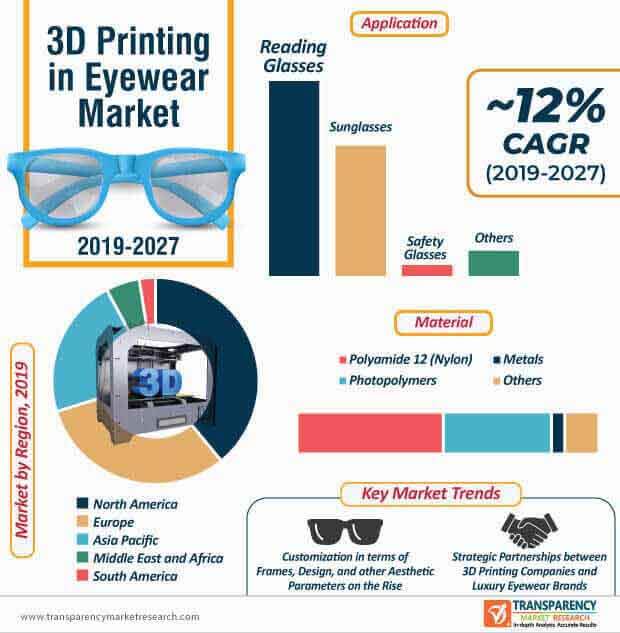
Is 3D Printing Revolutionizing the Eyewear Industry?
After gaining immense popularity in the healthcare industry, the adoption of 3D printing in eyewear market is growing at an impressive rate. Though the eyewear applications of 3D printing are still in a nascent stage, recent advancements in technology are putting an innovation spin to the market.
Though the 3D printing in eyewear market is still in its infancy, it carries massive potential for fetching profits, and can create tremendous opportunities for innovation. Taking this into consideration, Transparency Market Research (TMR) conducted a thorough study into how 3D printing technology is bringing in a new digital revolution in the eyewear market. It is a comprehensive research on the existing market opportunities and futuristic overview on how stakeholders in the 3D printing industry as well as the eyewear market can leverage these changes in market dynamics in the coming years.

Request a sample to get extensive insights into the 3D Printing in Eyewear Market
Lucrative Business Opportunities for 3D Printing Companies in the Eyewear Market
Innovation was, and still is, a trigger for the battle between market leaders and new entrants in the 3D printing in eyewear landscape. Yet, rise in the implementation of 3D printing in eyewear market is an end result of necessity more than that of the power of investments. As of 2019, the 3D printing in eyewear market is projected to be worth ~US$ 500 million, and is expected to increase at least 2.5X by the end of 2027.
Consumers are becoming aware about the expansive scope of 3D printing technology across industries, and how it can offer multitudinous features of consumer products. Thereby, a mounting number of stakeholders, including global leaders and startups in the eyewear market, are focusing on diversifying their product range with the adoption of 3D printing technology. Some of the examples include:
To understand how our report can bring difference to your business strategy, Ask for a brochure
In October 2019, a 3D printing company – Carbon, announced that it is entering into a partnership with J of JINS – a luxury eyewear brand from Japan, to launch its new eyewear brand –Neuron4D. The company is aiming to expand its line of 3D printed eyewear products using its digital light synthesis (DSL) technology for integrating 3D printed features into frames made with traditional materials from J of JINS.
In March 2019, Luxexcel – a leading manufacturer of 3D printed lenses – announced that it will be entering the ophthalmic and smart eyewear markets with its lenses 3D printed, using its VisionPlatform technology. The company further announced that its new eyewear product brings traditional lenses much closer to modern eyewear with in smart features.
In February 2018, Sculpteo – a French company specialized in 3D printing in the cloud – announced that it had established a partnership with a French startup and eyewear manufacturing company – Octobre71. The company announced that frames are manufactured using a polyamide material through a selective laser sintering (SLS) process, which is reliable, fast, as well as economical.
Investors and other leading stakeholders are noticing the beginning of the ‘3D revolution’ in eyewear designs and products, and this is likely to incur a sea of change in manufacturers’ strategies in this landscape, in the coming years.
Growing Popularity of Customization Underscores Emerging Market Trends
Even though the popularity of 3D printed sunglasses and other eyewear products is increasing at a rapid pace, consumer demand for 3D printed safety eyewear and ophthalmic products is still significantly low. The sales of 3D printed safety eyewear products account for merely 4% revenue share of the 3D printing in eyewear market.
In order to deal with this issue, market players may have to introduce products with safer and sturdier materials such as polyamide and meet the safety regulations established by governing bodies. However, another strategy that can help stakeholders boost their sales of 3D printed eyewear is to offer customization in the design of 3D printed eyewear.
A mounting number of leading developers in the 3D printing in eyewear market are focusing on introducing technology that can manufacture eyewear products according to the facial measurements of consumers. Introducing custom designs for every frame through 3D printing and meeting the specific needs of individual consumers is expected to emerge as a key to win in the eyewear market, in the coming years.





